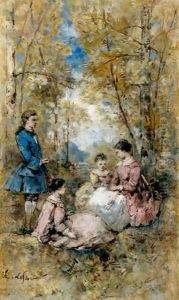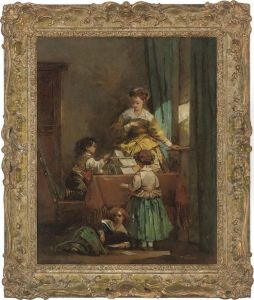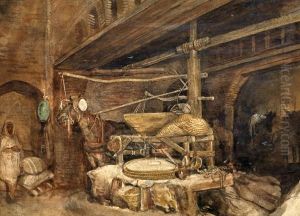Emile Aubert Lessore Paintings
Émile Aubert Lessore, born in 1805 in Paris, France, was a distinguished 19th-century artist known primarily for his talents as a ceramic painter and watercolorist. Within the evolving art scene of his time, Lessore managed to carve out a unique space for himself through his innovative approaches to ceramic art and his delicate watercolor scenes. His contributions to art were not just limited to his creative output but also extended to the significant influence he had on the revival of interest in ceramic decoration during the mid-19th century.
Lessore began his artistic journey with a focus on painting but soon found his passion in the more tactile art of ceramics. His early career saw him working at the Sèvres Porcelain Factory, a prestigious institution known for producing some of the finest ceramics in France. It was here that Lessore honed his skills, experimenting with various techniques and contributing to the factory's reputation with his exquisite designs. However, his ambition and creative spirit drove him to explore further opportunities, leading him to England, where he would make a lasting impact.
In the 1850s, Lessore started working with Minton, a renowned English ceramics manufacturer. His collaboration with Minton marked a significant period in his career, as he introduced innovative painting techniques that allowed for greater expression and detail in ceramic art. Lessore's work during this time was characterized by its artistic quality, bridging the gap between functional ceramics and fine art. His designs often featured scenes inspired by literature, mythology, and daily life, imbued with a sense of realism and emotional depth uncommon in ceramic decoration at the time.
Despite the commercial success and critical acclaim Lessore achieved in England, he eventually returned to France, where he continued to work and innovate until his death in 1876. Throughout his life, Lessore remained dedicated to his art, constantly seeking new ways to express beauty and narrative through the medium of ceramics. His legacy is evident in the lasting influence he had on the art of ceramic decoration, inspiring future generations of artists to explore the potential of this versatile medium.
Lessore's work is celebrated today for its technical mastery, artistic vision, and the significant role it played in elevating the status of ceramic art in the 19th century. His contributions to both French and English ceramics have cemented his place as a key figure in the history of decorative arts, with his pieces continuing to be admired and studied by art historians, collectors, and enthusiasts around the world.



